Developing the Young Workforce: annual report 2016-2017
The third annual report on Scotland's youth employment strategy, setting out progress in the academic year 2016 to 2017
Chapter 6: Performance Assessment and Evaluation
Key Performance Indicators
When we published Developing the Young Workforce ( DYW) - Scotland's Youth Unemployment Strategy in December 2014, we made a commitment to report annually on the progress of its implementation over its seven year life span.
The DYW programme has eleven Key Performance Indicators ( KPIs) which underpin the programme in terms of areas where we are focusing on improvement. These continue to be stretching and ambitious targets given the scale of change proposed, its complexity and the range of factors which will influence the programme's success. Alongside these, a number of milestones were identified for each theme which demonstrates what we expect the programme to achieve each year.
The table below outlines our progress to date in these eleven areas and briefing on each indicator.
To date, we are pleased to report good progress in good progress in:
- exceeding our overarching target of reducing the level of youth unemployment by 40 per cent by 2021;
- becoming one of the top five performing countries in the EU for youth unemployment;
- increasing in the percentage of school leavers attaining vocational qualifications at SCQF level 5 and above; and
- increasing the number of MA starts at level 3 and above year on year.
And that we still have further progress to make in:
- increasing the percentage of employers recruiting young people directly from education;
- reducing to 60 per cent the percentage of Modern Apprenticeship frameworks where the gender balance is 75:25 or worse by 2021;
- increasing the number of looked after children in positive destinations; and
- increasing the number of MA starts from minority ethnic communities.
KPI
Overarching target To reduce the level of youth unemployment (excluding those in full-time education) by 40 per cent by 2021
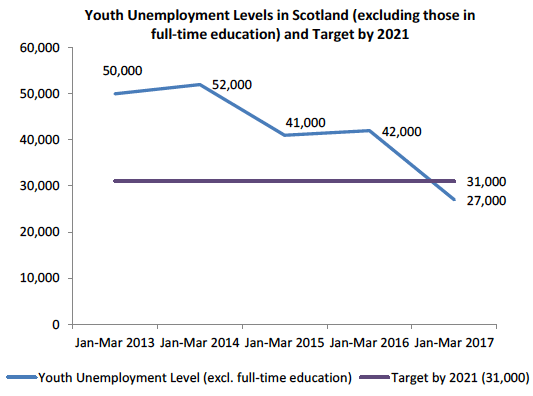
- When we first reported on the overarching target, the level of youth unemployment (excluding those in full-time education) in Scotland fell over the year from 52,000 in January-March 2014 to 41,000 in the same period in 2015.
- This figure has fallen to 27,000 in the same period in 2017. This means Scotland has exceeded its target of reducing youth unemployment to 31,000 four years early. This represents a 48% reduction in youth unemployment since the baseline figures were recorded in 2014.
- We must continue to focus on strengthening our education and skills partnerships to help us sustain this level.
Data Source and Frequency: Labour Force Survey ( ONS). Annual, using Jan-Mar data.
KPI 1
Be one of the top five performing countries in the EU for youth unemployment by reducing the relative ratio of youth unemployment to 25-64 unemployment to the level of the fifth best country in the EU by 2021
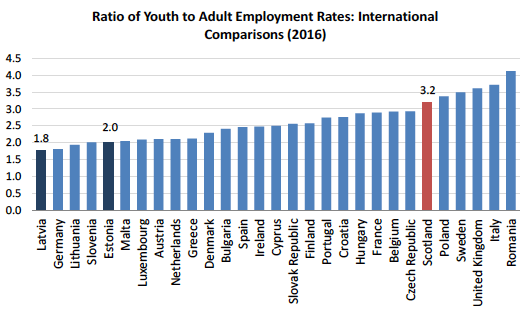
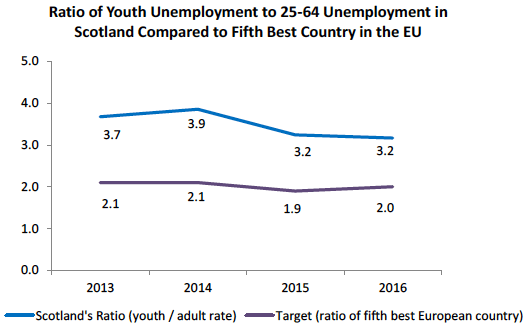
- The ratio has decreased since the baseline rates were measured. This is due to the reduction in the youth unemployment rate relative to the adult unemployment rate, e.g. for every 1 percentage point drop in the adult unemployment rate, the youth unemployment rate needs to fall about 3.2 percentage points for the ratio to be maintained.
- This ratio has remained stable since 2015.
Data Source and Frequency: Scotland data: Annual Population Survey ( ONS); EU data: OECD Stat. Scotland data: Annual, by calendar year; EU data: Annual
KPI 2
Be one of the top five performing countries in the EU for youth unemployment by reducing the youth unemployment rate to match the fifth best country in the EU by 2021
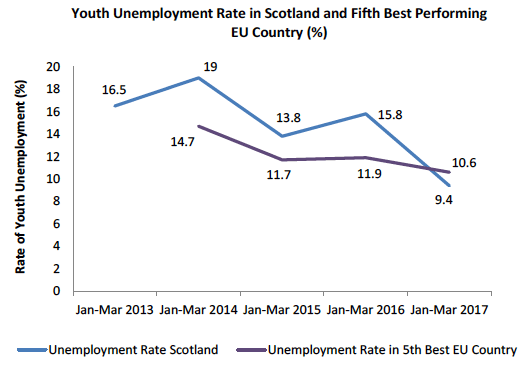
- The youth unemployment rate in Scotland fell from 19.0% in January-March 2014 to 13.8% in the same period in 2015 and then increased to 15.8% in the same period in 2016.
- The rate in Scotland is now 9.4%, making it the third best performing EU country.
Data Source and Frequency: Scotland data: Labour Force Survey ( ONS); EU data: Eurostat (European Commission). Scotland data: Annual, using Jan-Mar data; EU data: Annual, using February data
KPI 3
Increase the percentage of school leavers attaining vocational qualifications [2] at SCQF level 5 and above by 2021
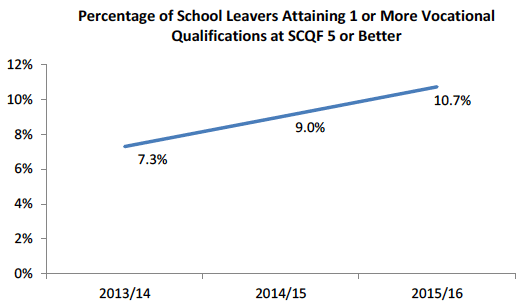
- There has been a positive increase in the number of school leavers achieving vocational qualifications since this indicator was first measured. 7.3% of 2013/14 school leavers achieved a vocational qualification. This increased to 9% of school leavers in 2014/15 and increased again to 10.7% of 2015/16 school leavers.
- We will publish annual updates to this figure in June each year going forward.
Data Source and Frequency: 2015/16 School Leaver Statistics: data from Awarding Bodies ( SQA for baseline data) and SG Pupil Census [3] . Annual Data.
KPI 4 [4]
Increase the percentage of 16-24 year old college students who have successfully completed a full time course moving into employment or higher level study
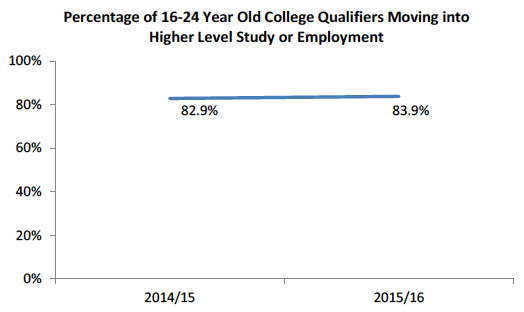
- The data for 14/15 has been used to baseline as this represents % of confirmed destinations of 16-24 year olds in a positive progression. (The data for 13/14 has not been used as this was experimental data.)
- The number of 16-24 year old college students moving into employment or higher level study after successfully completing a full-time course has increased by 1pp from 2014/15 to 2015/16.
Data Source and Frequency: College Leaver Destination Survey ( SFC) Annual, by college year
KPI 5
Increase the number of Modern Apprentices at level 3 and above. The target is for 20,000 out of a total of 30,000 MA starts to be at this level by 2021, i.e. two-thirds
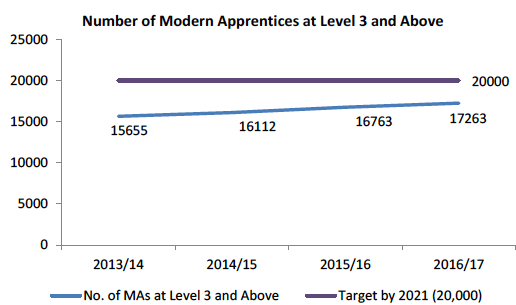
- The number of MA starts increased from 15,655 in 2013/14 to 16,112 in 2014/15. This has increased further to 16,763 in 2015/16 and to 17,263 in 2016/17.
- This consistent year on year increase suggests we are on target with this KPI.
Data Source and Frequency: Modern Apprenticeship Statistics: Full Year Report ( SDS). Annual, by financial year (April-March)
KPI 6
Increase the percentage of employers recruiting young people directly from education to 35 per cent by 2018
Baseline figure (2014): 32%
Current figure (2016): 32%
- This figure has remained stable at 32% since the baseline was measured in 2014.
Data Source and Frequency: Employer Perspectives Survey ( UKCES) [5] . Biennial, based on 'last 2-3 years' when respondents are surveyed
KPI 7
To reduce to 60 per cent the percentage of Modern Apprenticeship frameworks [6] where the gender balance is 75:25 or worse by 2021
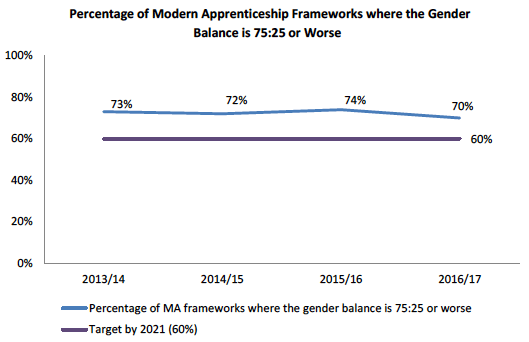
- The percentage decreased from 73% in 2013/14 to 72% in 2014/15, and fell to 70% in 2016/17.
- The MA Equalities Action Plan published on 2 Dec 2015 reports specific improvement targets on gender balance. SDS will report on this annually. The Year 1 update was published in July 2017.
Data Source and Frequency: Modern Apprenticeship Statistics: Full Year Report ( SDS). Annual, by financial year (April-March)
KPI 8
Increase by 5 percentage points the minority gender share in each of the 10 largest and most imbalanced college superclasses [7] by 2021
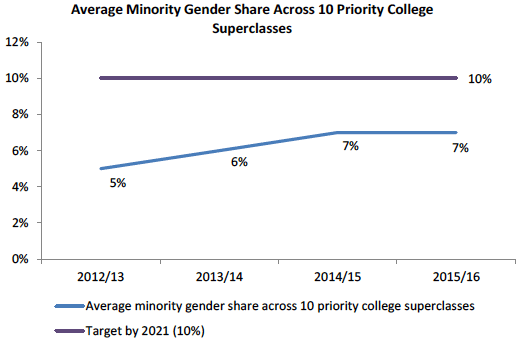
- The minority gender share increased by at least 1 percentage point in 3 out of the 10 largest and most imbalanced college superclasses between 2014/15 and 2015/16.
- The minority gender share increased by at least 1 percentage point in 6 out of the 10 largest and most imbalanced college superclasses from the baseline measurement in 2012/13.
- This ranges from 3% in building/construction operations (3% in 2012/13) to 12% in engineering/technology (general) (9% in 2012/13). The largest difference from the baseline was in building services (2% in 2012/13 to 7% in 2015/16).
Data Source and Frequency: Further Education Statistics collection ( SFC). Annual, by college year
KPI 9
Increase the number of MA starts from minority ethnic communities to equal the population share by 2021
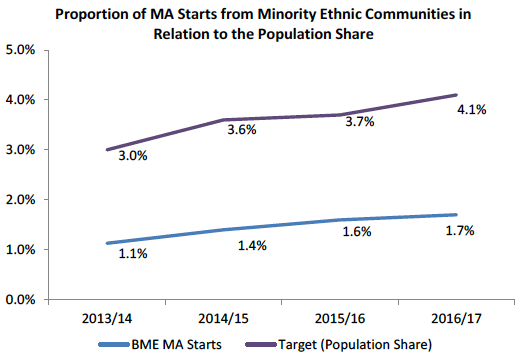
- The target will change year on year as the population share figure is updated
- The percentage of MA starts from minority ethnic communities increased from 1.1% in 2013/14 to 1.4% in 2014/15 and to 1.6% in 2015/16. This has further increased to 1.7% in 2016/17.
Data Source and Frequency: Modern Apprenticeship Statistics: Full Year Report ( SDS). Annual, by financial (April-March). Annual Population Survey ( ONS) (April-March).
KPI 10
Increase the employment rate for young disabled people to the population average by 2021
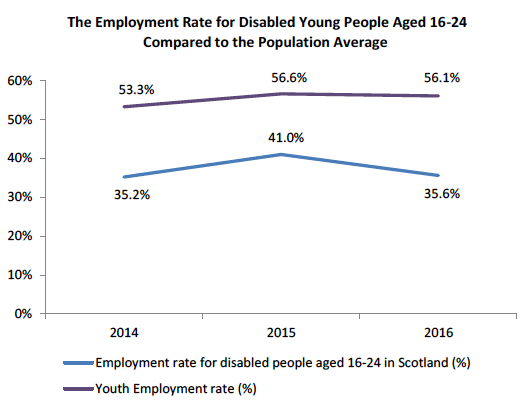
- The definition of disability in the Annual Population Survey changed during 2013. As a result, estimates for 2014 are not directly comparable with previous years.
- The employment rate for young disabled people increased from 35.2% in January–December 2014 to 40.8% for the same period in 2015. It decreased to 35.6% during the same period in 2016.
Data Source and Frequency: Annual Population Survey ( ONS) Annual, by calendar year
KPI 11
Increase positive destinations for looked after children by 4 percentage points per annum resulting in parity by 2021 [8]
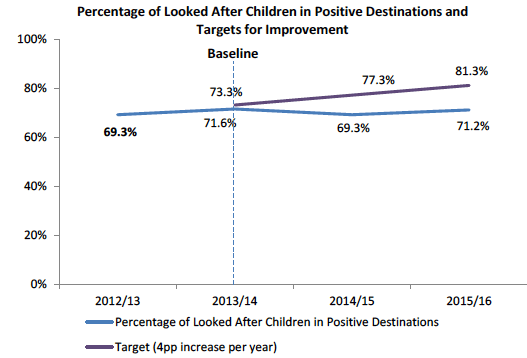
- The “looked after children‟ cohort reflects children who have been looked after for the full year only.
- The number of looked after children in positive destinations is 71.2% in 2015/16. This is an increase of 1.9pp since the baseline figures were recorded in 2012/13.
Educational Outcomes for Looked After Children ( SG). Annual, by school year
Contact
There is a problem
Thanks for your feedback